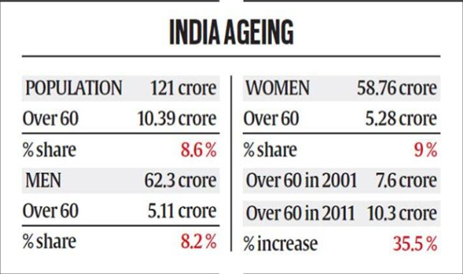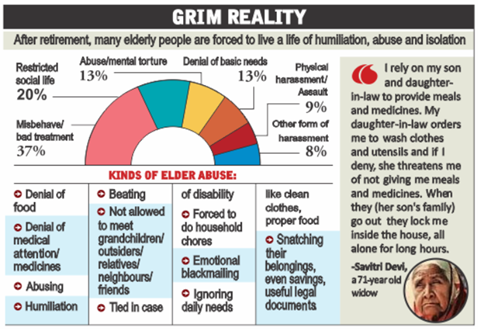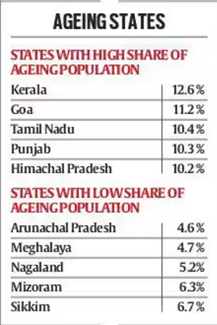Mass Aging: Unprecedented Challenge Ahead
Relevance
- GS Paper 2 Issues Relating to Development and Management of Social Sector/Services relating to Health, Education, and Human Resources.
- Tags: #GlobalAgeing #COVID19 #Pension #MintEditorial #UPSCMains2024 #UPSCPrelims2024 #UPSCPrelims #demographicshift.
Why in the News?
In an unprecedented demographic shift, the world’s population is aging rapidly. This transformation, driven by declining fertility rates and increasing longevity, poses substantial challenges and opportunities.
Global Aging Trends
- The world’s elderly population, those aged 65 and older, is growing quickly.
- In 2022, they made up 10% of the global population, and this percentage is projected to reach 16% by 2050 and nearly 25% by the end of the century.
- Highlighting the significant challenges and changes associated with aging societies.
Global Ageing Reality
- Aging is now the prevailing demographic trend worldwide, driven by factors like reduced birth rates, longer lifespans, and large cohorts entering old age.
- Over the past century, global life expectancy has more than doubled, and this trend is expected to persist.
- Simultaneously, fertility rates have decreased worldwide, with many developed countries reporting rates around 1.3 or lower.
- For instance, South Korea recently had a fertility rate of 0.9.
- Even India’s fertility rate has halved to 2.0 in just four decades, highlighting the universal shift towards an older population structure.
Resilience of Global Ageing Trend
- Despite the COVID-19 pandemic, which led to around 15 million deaths and a temporary decrease in life expectancy.
- The powerful trend of global aging remains largely unaffected.
- The pandemic’s long-term impact on birth rates is still uncertain.
Global Ageing Challenges
- All countries must prepare their social and healthcare systems for the significant shift in demographics.
- While the trend started in wealthy nations like Japan and Germany, it’s now affecting low and middle-income countries the most.
- By mid-century, two-thirds of elderly individuals will reside in these nations.
- This shift coincides with climate change, creating additional financial strains for countries already dealing with limited resources.
- The challenge is to support the growing elderly population while addressing environmental issues, making it a double burden on nations.
Aging Societies: Opportunities and Challenges
- As societies get older, there’s a chance to benefit from the valuable experiences of elderly individuals.
- Their skills and knowledge can be assets if harnessed systematically and creatively.
- However, significant challenges include income security, healthcare, and preserving the dignity of the elderly, making it essential to address these aspects as our population ages.
India’s Ageing Challenge
- India already has nearly 100 million elderly people, and by the end of the century, this number will reach 330 million.
- This poses immediate challenges like elder care, healthcare, and financial security.
- While India focuses on youth employment, it must also address issues like rising the retirement age, boosting employer contributions to pensions, and encouraging savings for the elderly.
Demographic Variations in India
- India’s states have varying demographic structures.
- Wealthier states like Maharashtra, Tamil Nadu, Gujarat, Karnataka, and Kerala have lower fertility rates below 2.0.
- In contrast, Uttar Pradesh (UP) has a rate of 2.4, and Bihar’s rate is the highest at 3.0.
- These results in differences in median ages – states like Tamil Nadu and Maharashtra will have older populations around 40, while Bihar and UP will have younger populations around 30 over the next decade.
- In addition, women often outlive males by around 3–4 years, which makes the issue of financial security worse.
Pension Challenges
- India, like other developing nations, isn’t fully ready for its changing demographics.
- Traditional, guaranteed benefit pensions are costly for employers, while newer contribution-based plans often don’t provide enough to support longer lifespans.
- This leaves a gap in funding elder care.
- As the number of school-going children decreases in some areas, we may need to close schools and open more hospitals to cater to the growing elderly population, which is a significant challenge.
Solutions for Complex Challenges
- Raising Retirement Age: Gradually increasing the retirement age can extend the productive years of individuals, allowing them to work and receive income security for a more extended period.
- Health and Wellness: Strengthening healthcare and wellness efforts throughout a person’s life, from early motherhood to addressing lifestyle diseases, can increase the number of healthy years (health spans) and reduce the financial strain on households and society.
- Balanced Nutrition: Shifting from a calorie-centric mindset to one focused on balanced nutrition can improve overall health and well-being.
- Enhanced Savings: Increasing the allowable contributions to Defined Contribution (DC) plans is necessary to ensure savings can support longer lifespans.
“In the end, it is not the years in your life that count. It’s the life in your years,” Abraham Lincoln.
|
Government of India Schemes for Ageing People 1. National Programme for Healthcare of the Elderly (NPHCE)
2. Varishtha Pension Bima Yojana (VPB Yojana)
3. National Social Assistance Programme (NSAP)
4. Rashtriya Vayoshri Yojana (RVY)
|
Source: Livemint
Mains Question
What are the challenges and opportunities presented by the increasing elderly population, especially in low and middle-income countries? How can these challenges be effectively addressed?






